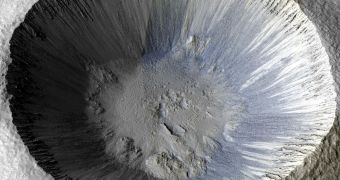Experts at the University of Western Ontario reveal in a new study that pits formed at the bottom of certain Martian craters were produced by subsurface volatile materials, such as water or ice. These landscape features were thought to be rare, but the new analysis showed that was not the case.
The research was conducted on images sent back to Earth by the High Resolution Imaging Science Experiment (HiRISE) instrument, aboard the NASA Mars Reconnaissance Orbiter (MRO). The spacecraft has been orbiting Mars since 2006.
Since then, HiRISE has been continuously mapping the Red Planet's surface, producing the most accurate images ever taken of another world. The high resolution of these photos is what allowed experts at UWO to identify the surface pits.
Previous studies seemed to suggest that these features formed rarely, but the new work proves that pits commonly arise at the bottom of craters. According to the research team, volatiles are the most likely candidates as a trigger for this process.
“These images present evidence that there is a connection between volatiles like water and ice in the subsurface of Mars and the impact process,” explains former HiRISE operator Livio Tornabene.
The expert, an ongoing member of the mission's science team, is an adjunct research professor on the UWO Department of Earth Sciences. He also holds an appointment as an investigator at the Center for Planetary Science and Exploration (CPSX).
“A meteor impact obviously delivers a lot of energy and heat to the surface of Mars, so if you have frozen water present underground then heat delivered by the impact is going to react with it,” he adds.
However, he cautions that the new data are not final, saying that Mars is still displaying geological activity. Unlike the Moon, whose interior is dead, the Red Planet is still alive to some extent, which means that other geological processes may have produced the pits.
But the most likely explanation – supported by past discoveries as well – is that water or ice turned into gas as soon as the asteroids hit, and led to the collapse of the ceiling above them, forming the pits.
“Unlike the Moon, it's hard to prove if craters on Mars formed the phenomenon or did they come later as a consequence of other geologic processes that occurred after the impact crater formed,” Tornabene concludes.

 14 DAY TRIAL //
14 DAY TRIAL //